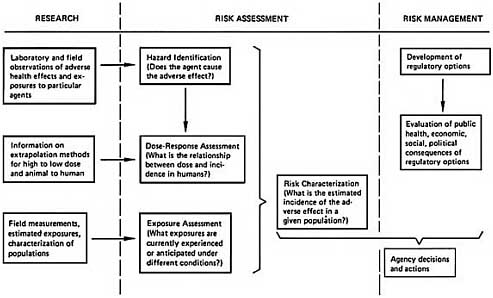3
Revision of 1983 Framework To Incorporate Ecological Risk Assessment
COMPONENTS OF THE 1983 FRAMEWORK
Risk Assessment in the Federal Government: Managing the Process (NRC, 1983), often called the "Red Book," proposed a conceptual framework for risk assessment that incorporates research, risk assessment, and risk management (Figure 3-1). Risk assessment was defined as "the characterization of the potential adverse health effects of human exposures to environmental hazards." The overall scheme and terminology proposed in the 1983 report entailed hazard identification, dose-response assessment, exposure assessment, and risk characterization. Hazard identification was defined as "the process of determining whether exposure to an agent can cause an increase in the incidence of a health condition," including "characterizing the nature and strength of the evidence of causation.'' Dose-response assessment was defined as "the process of characterizing the relation between the dose of an agent administered or received and the incidence of an adverse health effect … as a function of human exposure to the agent," accounting for exposure intensity, age, sex, lifestyle, and other variables affecting human health responses to hazardous agents. Exposure assessment was defined as "the process of measuring or estimating the intensity, frequency, and duration of human exposures to an agent currently present in the environment or of estimating hypothetical exposures that might arise from the release of new chemicals into the environment." Risk characterization was defined



